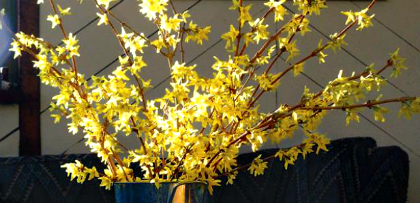It's Time to Grow Peas in Austin!
by Amanda Moon
Okay central Texas gardeners… listen closely because you only
have a few weeks! Do I have your attention? Good.
From approximately mid-January to mid-February you can plant
peas and harvest them before the heat hits, usually right after
Mother’s Day (if we’re lucky).
Are they worth growing for such a short window? Absolutely!
Peas are high-yielding vines that can produce quite a bit in their
short southern life. They come in three forms:
Shelling or English Peas These are the traditional peas that we
buy shelled frozen or canned (please don’t buy canned!). The outer
shell is inedible and the peas are removed the same way. (Packets
available from $1.79 - $2.49.)
Snap Peas can be quite sweet, as in sugar snap peas, and are gen-
erally rounded and plump in shape. The peas can be shelled out,
but the pod is edible and can be eaten raw or cooked. These are
my favorites to break up and eat raw for a healthy, sweet snack.
(Available for 50 cents a scoop.)
Snow Peas Traditional peas used in a stir fry. They are flat and
grown for their low-fiber shells, not their super small peas. Typi-
cally not as sweet as snap peas. (Available for $1.79 - $2:49.)
When shopping for pea seeds, there are a few things to keep in
mind. Look for lower 'days to maturity.' Fifty days works better for
us here in central Texas than 65 or 70 days or more.
The varieties also need to be disease resistant. Fusarium wilt and
powdery mildew can be problems, especially when we get a colder,
wetter winter.
Texas A&M Agrilife recommends snap peas Cascadia, Sugar Ann,
Sugar Bob, Super Sugar Snap and heirloom Amish, and Premium,
a shelling type.
I have had success in a raised bed in my Round Rock garden with
Cascadia, Sugar Ann and Green Arrow, another shelling pea. I will
probably wait on the Green Arrow this year as it takes longer to
mature and our soil is cool enough to slow germination.
There are several varieties, including Green Arrow and Cascadia
that have vines so short (under 30”) that they are self-supporting
when planted only a few inches a part.
This is a handy trick in very small gardens like mine. Others will
need some sort of support system. You can train them along wire,
along fencing or they can wrap themselves around a bamboo teepee.
You might consider solarizing your soil for a few days to warm it
up, especially if you are growing in a raised bed. This may help to
speed up germination, in case we get an early summer.
The plants are frost-tolerant, but will need some protection when
we get a hard freeze. Make sure your garden soil is well-drained
and plant in an area that will have good air circulation all the way
through to harvest (i.e. watch the final size of surrounding veggies).
To keep disease to a minimum, water from below the foliage rather
than above.
Peas are classified as legumes and are able to produce their own
food or fertilizer in the form of 'nitrogen fixing.' This refers to the
peas amazing ability to convert nitrogen from the air into a form
that the pea can use for growth and production.
They are traditionally inoculated with a bacteria to increase the
ability of the roots to convert more nitrogen, leading to higher
yields and stronger plants, especially in new gardens. This is not
a requirement and I have had good success without that extra step.
When your lovely peas are ready for harvest in about 6 weeks
from germination, get ready! They grow as fast as okra and will
need to be checked and harvested daily to make sure they keep
producing and the pods don’t become too tough to eat.
You can keep fresh peas in the fridge for several weeks, but they
are best eaten fresh or frozen quickly as the sugar content degrades
as soon as they are picked, similar to sweet corn.
The pods are edible at any length, but I like to let them get to about
2 – 3 inches. I then grab them to throw in my evening salad . . . if
they don’t get eaten on the way back in to the house ; - )
Happy gardening everyone! ❦







